Indoor Air Quality Monitoring System Market Size and Forecast 2025 to 2034
The global indoor air quality monitoring system market size accounted for USD 7.95 billion in 2024 and is predicted to increase from USD 8.67 billion in 2025 to approximately USD 18.89 billion by 2034, expanding at a CAGR of 9.04% from 2025 to 2034. Public awareness of the benefits of indoor air quality monitoring systems is increasing, along with a heightened focus on improving indoor air quality, stricter government regulations for pollution control, rising urbanization, a growing population, and rapid technological advancements in indoor air quality monitoring systems.
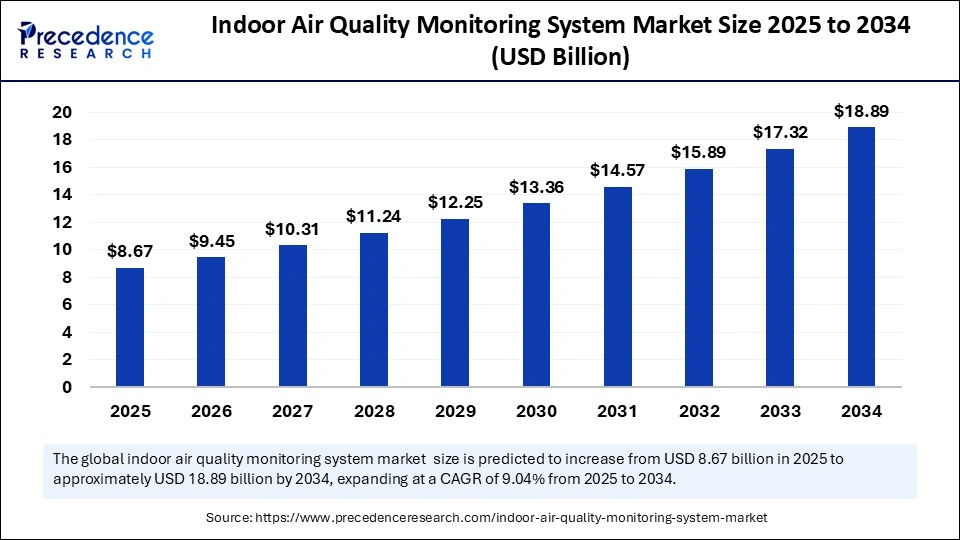
Indoor Air Quality Monitoring System Market Key Takeaways
- North America dominated the global market with the largest share of 38% in 2024.
- Asia Pacific is observed to expand at the fastest rate during the forecast period.
- By component, the hardware segment accounted for the dominating market share in 2024.
- By component, the software segment is expected to witness significant growth during the forecast period.
- By end users, the commercial segment accounted for the highest market share of 45% in 2024.
- By end users, the industrial segment is expected to witness remarkable growth during the forecast period.
Artificial Intelligence (AI) Improving Indoor Air Quality
In the era of a rapidly evolving digital landscape, the integration of artificial intelligence emerges as a transformative force and holds great potential to impact the growth of the indoor air quality monitoring system market. AI-powered sensors are capable of monitoring, analyzing, and improving air quality by detecting harmful pollutants in real time. AI integration in indoor air quality monitoring systems builds an accurate picture of indoor air conditions.
AI-enhanced indoor air quality monitoring systems utilize numerous sensors to track carbon dioxide (CO2) levels, particulate matter (PM2.5 and PM10), temperature and humidity levels, volatile organic compounds (VOCs), and airborne bacteria. Therefore, AI integration significantly improves air quality monitoring systems through its ability to continuously analyze and adjust environmental parameters.
U.S. Indoor Air Quality Monitoring System Market Size and Growth 2025 to 2034
The U.S. indoor air quality monitoring system market size was exhibited at USD 7.95 billion in 2024 and is projected to be worth around USD 5.49 billion by 2034, growing at a CAGR of 9.23% from 2025 to 2034.
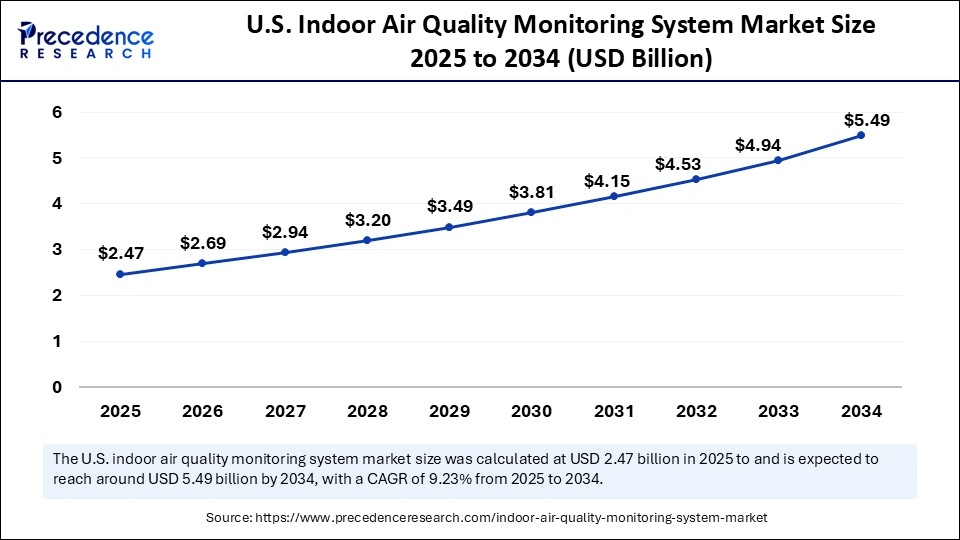
North America held the dominant share of the indoor air quality monitoring system market in 2024. The growth of the region is attributed to the presence of stringent air quality regulations and standards, increasing awareness of indoor air pollution and its adverse health impacts, the rising significance of healthier indoor air quality, the increasing focus on the control of pollution in enclosed spaces, and rapid technology innovation in indoor air quality monitoring devices.
The rise in disposable income, along with the rising adoption of smart home ecosystems, has driven the need for indoor air quality monitoring systems. These products can integrate with various smart gadgets; the air quality can be continuously monitored in real-time for healthier living conditions. Due to the rising pollution levels, several Governments in the region implemented rigorous regulations for air quality standards, bolstering the growth of the indoor air quality monitoring system market.
In addition, the rising prevalence of lung diseases and respiratory disorders, such as COPD and asthma, is accelerating the regional expansion in the coming years. According to the American Lung Association, indoor air can be 2-5 times, even up to 100 times, more polluted than outdoor air. Americans spend 90% of their time indoors. Also, COPD affects 11.7 million people in America, accounting for millions of emergency department visits and tens of billions in healthcare costs each year.
Poor air quality impacts everyone, but especially people with lung disease and other underlying health conditions. According to the Environmental Protection Agency (EPA), individuals living in the U.S. typically spend up to 90% of their time in an indoor environment, either at work or at home. According to June 2023 data, indoor air is 100 times more contaminated than outside air. Several populations spend 80% to 90% of their time indoors.
On the other hand, Asia Pacific is observed to expand at the fastest rate during the forecast period. The rapid growth is driven by the rising research and development efforts to launch the development of innovative IAQ devices, an increase in the development of smart cities projects, rapid urbanization & industrialization, rising concern over indoor air quality, and a supportive Government framework. Several countries in the region are taking numerous initiatives to tackle air pollution in the Asia-Pacific region, such as China, Japan, South Korea, and India.
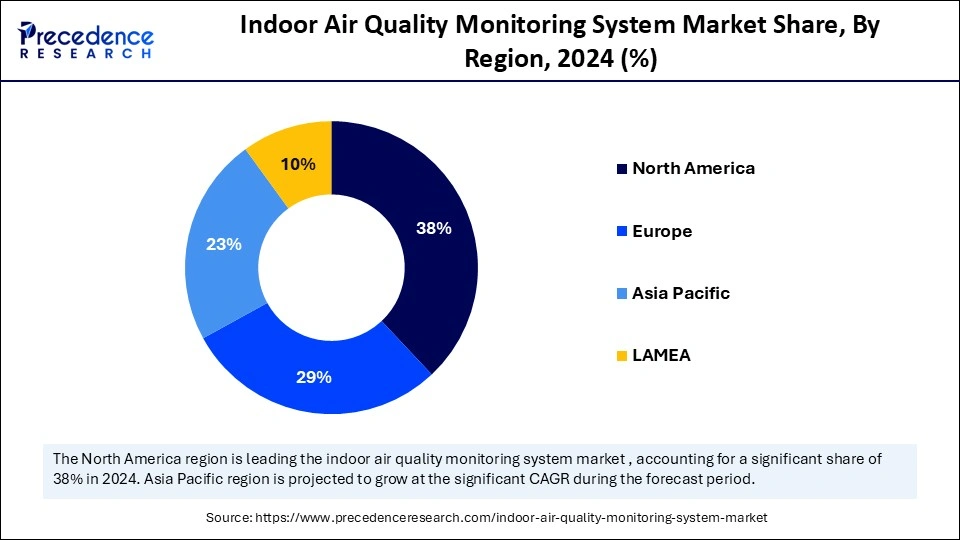
The indoor air quality monitoring system market is witnessing increased adoption of the indoor air quality monitoring system, particularly in residential and commercial spaces, fueled by growing awareness regarding the adverse health impacts of poor indoor air quality. According to the report published by IQAir in March 2024, Bangladesh recorded a PM level of 79.9 micrograms per cubic meter, Pakistan has a PM level of 73.7 micrograms per cubic meter, India has a PM level of 54.4 micrograms per cubic meter, Tajikistan has a PM level of 49 micrograms per cubic meter, and Burkina Faso has a PM level of 46.6 micrograms per cubic meter. Additionally, the significant surge in the air pollution index has resulted in an increasing demand for an indoor air quality monitoring system.
- In May 2024, Thermo Fisher Scientific announced the commencement of manufacturing of Air Quality Monitoring System (AQMS) analyzers in India. The analyzers will be engineered, manufactured, and validated at Thermo Fisher's facility in Nasik, Maharashtra.
The European indoor air quality monitoring system market is expected to expand at a rapid pace during the forecast period, owing to the increasing awareness of fresh indoor air quality, rising employee health and safety concerns, rising utilization of wireless connections for data transmission, and increasing adoption of IAQ monitoring technologies. In addition, the favourable government regulations assist in improving indoor air quality. These regulations significantly increase the adoption of IAQ products and practices, ensuring healthier living spaces and working environments.
The rising adoption of smart homes, increasing focus on industrial safety protocols, and IoT-based solutions, accelerating the indoor air quality monitoring system market's revenue. Furthermore, the surge in indoor air pollution owing to several factors, including emissions from household appliances, dust, and harmful chemicals, is likely to spur the demand for innovative IAQ solutions to maintain a safe indoor environment.
Market Overview
Indoor Air Quality (IAQ) monitoring systems are devices that are designed to assess pollutant levels such as carbon monoxide (CO), carbon dioxide, volatile organic compounds (VOCs), particulate matter (PM2.5 & PM10), humidity, and temperature within indoor spaces. These sensors enable to fetch of real-time data, which aids in detecting contaminants present in indoor air. The poor indoor air quality impacts everyone, including children, adults, and the elderly, but is more susceptible to individuals with health conditions like asthma and heart disease. Healthy indoor environments facilitate higher productivity, boost performance, and optimize energy. Indoor air quality monitoring plays a crucial role in maintaining the balance of well-being and energy efficiency, particularly in public spaces such as hotels, hospitals, office buildings, conference centers, airports, shopping malls, and others.
| Rank | World Air Quality Index (AQI) Ranking | AQI |
| 1 | Delhi, India | 291 |
| 2 | Riyadh, Saudi Arabia | 215 |
| 3 | Lahore, Pakistan | 184 |
| 4 | Kuwait City, Kuwait | 163 |
| 5 | Dakar, Senegal | 156 |
| 6 | Wuhan, China | 143 |
| 7 | Kolkata, India | 132 |
| 8 | Karachi, Pakistan | 113 |
| 9 | Kathmandu, Nepal | 112 |
| 10 | Ulaanbaatar, Mongolia | 104 |
Indoor Air Quality Monitoring System Market Growth Factors
- The supportive government regulations and initiatives to safeguard human health and ensure comfort in indoor environments, accelerating the indoor air quality monitoring system market's revenue during the forecast period.
- The growing awareness regarding the risks associated with contaminated indoor air quality is expected to spur the demand for an indoor air quality monitoring system during the forecast period. People are increasingly becoming more conscious of the adverse impact of air pollutants on human health.
- The rapid urbanization and industrialization have significantly increased the importance of healthier indoor air quality, propelling the growth of the indoor air quality monitoring system market in the coming years.
- The surge in the number of smart cities, along with the growing demand for innovative solutions to reduce emissions and improve building efficiency, significantly fuels the market's growth.
- The increasing incidence of respiratory diseases, such as asthma, COPD, and others, is anticipated to boost the growth of the market. Exposure to poor air quality can cause serious respiratory disorders, especially asthma and allergies, which in turn necessitate the need for an indoor air quality monitoring system.
Market Scope
| Report Coverage | Details |
| Market Size by 2034 | USD 18.89 Billion |
| Market Size in 2025 | USD 8.67 Billion |
| Market Size in 2024 | USD 7.95 Billion |
| Market Growth Rate from 2025 to 2034 | CAGR of 9.04% |
| Dominating Region | North America |
| Fastest Growing Region | Asia Pacific |
| Base Year | 2024 |
| Forecast Period | 2025 to 2034 |
| Segments Covered | Component, End Use, and Regions |
| Regions Covered | North America, Europe, Asia-Pacific, Latin America, and Middle East & Africa |
Market Dynamics
Drivers
Rising concern over indoor air quality
The increasing concern over indoor air quality is expected to drive the growth of the indoor air quality monitoring system market during the forecast period. The most common indoor air quality issues include high levels of CO₂, PM, and VOCs, poor ventilation, and excess humidity. The poor air quality can cause various health problems such as COPD, palpitations, migraines, dizziness, and lung cancer.
The adoption of indoor air quality monitoring assists in monitoring and optimizing indoor air quality for healthier spaces, which can affect the productivity and well-being of occupants. Therefore, the rising need for pollution control within offices, households, factories, and other public areas spurs the demand for indoor air quality monitoring systems to help promote better quality indoor environments.
According to the article published by the WHO in October 2024, nearly 2.1 billion people around the world cook food using open fires or inefficient stoves fuelled by kerosene, biomass, and coal, which generates harmful household air pollution. Most of these people are poor and live in low- and middle-income countries.
Restraint
High Initial Investment
The high initial investment cost associated with the installation of indoor air quality monitoring systems is anticipated to hamper the market's growth. The installation of high-cost indoor air quality monitoring systems requires an adequate amount, which often acts as a barrier and results in slow adoption in several low and middle-income countries.
Rising emphasis on sustainability
The increasing focus on sustainability is projected to offer lucrative opportunities to the indoor air quality monitoring system market during the forecast period. Several countries around the world have taken numerous sustainability initiatives, which have resulted in cutting down on energy costs and have significantly increased the adoption of indoor air quality monitoring systems in residential, commercial, and industrial buildings.
In energy-efficient buildings, proper air filtration systems play a crucial role in reducing power consumption and creating a healthy indoor environment. The advanced indoor air quality monitoring system optimizes heating, ventilation, and air conditioning (HVAC) systems, which provide a healthier indoor atmosphere that is safe for human health.
Component Insights
The hardware segment accounted for the dominating indoor air quality monitoring system market share in 2024. Hardware materials in the indoor air quality monitoring system play a vital role in air quality monitoring, such as sensors, a microcontroller, a communication module, and a display. These measures include harmful pollutants, including volatile organic compounds (VOCs), particulate matter (PM), humidity, carbon dioxide (CO2), and temperature, providing a complete overview of air quality in indoor areas.
On the other hand, the software segment is expected to witness a significant growth during the forecast period. Software is crucial in the accurate analysis, visualization, and reporting of real-time air quality data collected through the hardware devices. AI-powered software solutions offer continuous real-time monitoring and ensure safe air quality in the indoor environment.
End Users Insights
The commercial segment accounted for the highest indoor air quality monitoring system market share. The growth of the segment is driven by the rising demand for air quality monitoring systems in commercial buildings such as hospitals, retail, hotels, conference centers, shopping malls, airports, offices, and educational institutions, where an indoor healthy environment is important. The adoption of an indoor air quality (IAQ) monitoring system directly impacts health, productivity, and regulatory compliance in commercial buildings. Such factors are propelling the growth of the segment in the coming years.
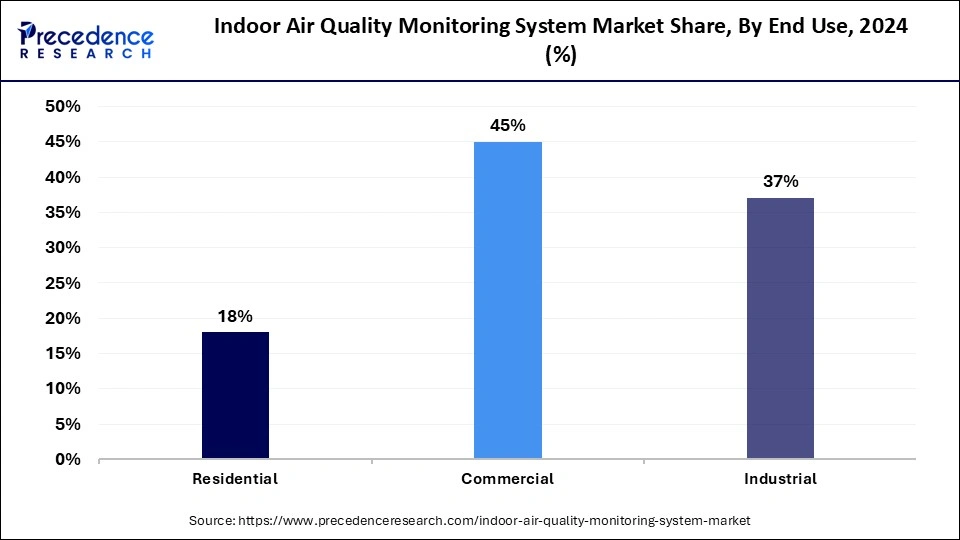
On the other hand, the industrial segment is expected to witness remarkable growth during the forecast period. Several industries are widely deploying indoor air quality monitoring systems to identify pollutants like CO₂, VOCs, and PM2.5, and ensure a safe indoor environment in industrial spaces to protect the workers' health as well as comply with the laws. Airborne pollutants in factories and manufacturing facilities can cause severe health issues such as asthma attacks, heart palpitations, migraines, dizziness, lung cancer, and others. Thus, the utilization of an indoor air quality monitoring system assists in effectively monitoring and optimizing indoor air quality in industrial spaces.
Indoor Air Quality Monitoring System Market Companies
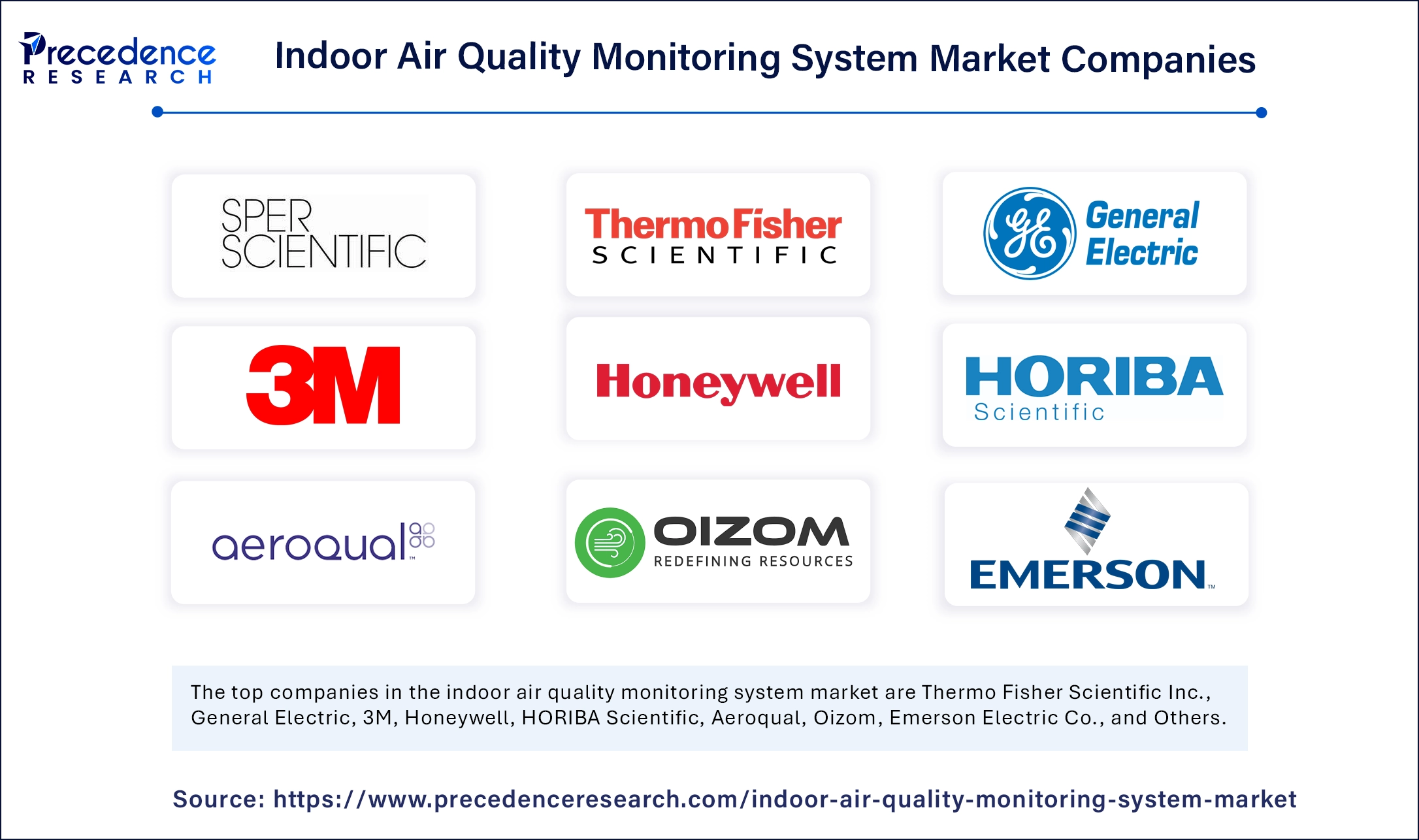
- Sper Scientific Direct
- Thermo Fisher Scientific Inc.
- General Electric
- 3M
- Honeywell
- HORIBA Scientific
- Aeroqual
- Oizom
- Emerson Electric Co.
- Seimens
- Merck KGaA
- Teledyne Technologies Incorporated.
- Testo SE & Co. KGaA
Latest Announcements by Industry Leaders
- In July 2024, the CSIR-National Institute for Interdisciplinary Sciences (NIIST) developed self-powered indoor air quality monitors that have been installed at the Thiruvananthapuram International Airport in Kerala to keep a close tab on air quality parameters at the airport. The partnership between CSIR-NIIST and the airport is an example of translating high-end scientific research into a practical application.
Recent Developments
- In August 2024, Renesas Electronics Corporation, a premier supplier of advanced semiconductor solutions, today introduced an advanced all-in-one sensor module designed for indoor air quality monitoring. The RRH62000, the first multi-sensor air quality module from Renesas, integrates multiple sensor parameters in a compact design and accurately detects different particle sizes, volatile organic compounds, and gases harmful to human health.
- In April 2025, Fellowes announced the launch of its Array networked air purification system, featuring building management system (BMS) integration via BACnet/IP. Array provides continuous, real-time IAQ monitoring and automatic adjustments to ensure consistently clean, comfortable, and safe indoor air while reducing energy costs.
- In January 2025, WellStat, a US-based leader in energy management and air quality solutions, announced the acquisition of UK-based Iknaia Limited and its highly innovative Airscan product range. This acquisition enhances WellStat's global reach and expands its integrated product portfolio, combining Iknaia's indoor and outdoor air quality monitoring expertise with WellStat's existing capabilities in air quality management, energy optimization, and intelligent building management.
Segments Covered in the Report
By Component
- Hardware
- Software
- Services
By End Use
- Residential
- Commercial
- Industrial
By Region
- North America
- Europe
- Asia-Pacific
- Latin America
- Middle East & Africa
For inquiries regarding discounts, bulk purchases, or customization requests, please contact us at sales@precedenceresearch.com
Frequently Asked Questions
Ask For Sample
No cookie-cutter, only authentic analysis – take the 1st step to become a Precedence Research client
 sales@precedenceresearch.com
sales@precedenceresearch.com
 +1 804-441-9344
+1 804-441-9344